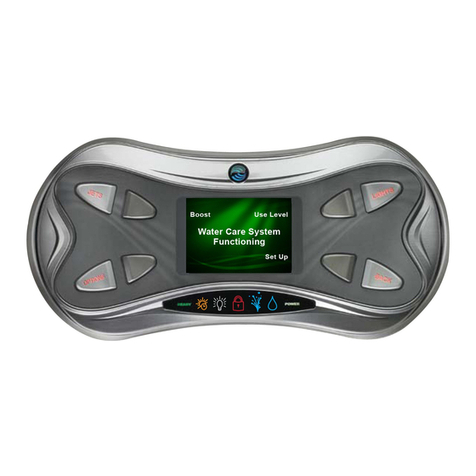
AGW–4015/4025/4045 Installation & Operations Manual
IMPORTANT SAFETY INSTRUCTIONS
READ AND FOLLOW ALL INSTRUCTIONS.
Read this manual completely before operation of AGW–4015/4025/4045 Ozone Generator Equipment. The High Voltage
Transformers in this unit create 7,000 volts, with the outer jacket of the High Voltage lead reaching 3,000 volts.
- USE EXTREME CAUTION -
Operate the AGW–4015/4025/4045 on a near level surface with safe access to electrical power.
Connect to a G.F.C.I. type receptacle.
Follow all applicable electrical codes.
Do not bury cord.
WARNING: To reduce the risk of electrical shock, replace damaged cord immediately.
ELECTRICAL SHOCK HAZARD: Turn OFF all power switches and disconnect power cord from power source receptacle
before performing any service work. Failure to do so could result in serious injury or death.
SAFETY CLAIMS
Performance safety testing was based on the Hazard Communication Standard as promulgated through the Occupational Safety
and Health Act of 1970 and documented in the Code of Federal Regulations, Title 29, Chapter XVII, Part 1910, Section 1910.1200.
The inherent low hazard due to the AGW–4015/4025/4045’s design and construction, coupled with the safety features, monitoring
data, and the precautionary directions provided in the owner’s manual are sufficient for The Toxicology Group, LLC, a division of NSF
International (Ann Arbor, MI), to provide a professional opinion that the AGW–4015/4025/4045 Mobile Recirculating Ozone Sanitation
System poses no safety concerns when operated under the prescribed conditions as set forth in the owner’s manual.
ANTIMICROBIAL CLAIMS
This device has been determined acceptable for use as an ozone generating device providing sanitization and disinfection of hard,
inanimate, pre-cleaned surfaces, in and around food processing areas (P1). A potable water rinse is not required following the use of
this device on previously cleaned hard surfaces.
NSF International Registration for this device is based, partially, upon documentation indicating that it meets all necessary requirements
including labeling, EPA Establishment Registration, and safety requirements set forth under Federal Insecticide, Fungicide, and
Rodenticide Act (FIFRA) of June 5, 1947, Section 2(q)(1) and Section 7.
Efficacy studies conducted according to AOAC Official Method 961.02; Germicidal Spray Products as Disinfectants Test and AOAC
Official Method 960.09*; Germicidal and Detergent Sanitizing Action of Disinfectants provided the following results:
Organism Applied Dose Actual Dose (at nozzle) Spray Duration Reduction
Trichophyton mentagrophytes
(ATCC 9533)
3.0 ppm 1.85-2.25 ppm 30 seconds 6 log (99.9999%)
Salmonella choleraesuis
(ATCC 6538)
3.0 ppm 1.85-2.25 ppm 3 minutes 6 log (99.9999%)
Staphylococcus aureus
(ATCC 6538)
3.0 ppm 1.85-2.25 ppm 10 minutes 6 log (99.9999%)
Pseudomonas aeruginosa (ATCC
15442)
3.0 ppm 1.85-2.25 ppm 5 minutes 6 log (99.9999%)
Campylobacter jejuni
(ATCC 15442)
3.0 ppm 1.85-2.25 ppm 3 minutes 4 log (99.99%)
Listeria monocytogenes
(ATCC 7644)
3.0 ppm 1.85-2.25 ppm 3 minutes 4 log (99.99%)
Aspergillus flavus
(ATCC 9296)
3.0 ppm 1.85-2.25 ppm 5 minutes 4 log (99.99%)
Brettanomyces bruxellensis
(ATCC 10560)
3.0 ppm 1.85-2.25 ppm 3 minutes 4 log (99.99%)
Escherichia coli*
(ATCC 11229)
3.0 ppm 2.1 ppm 30 seconds 5 log (99.9999%)

















